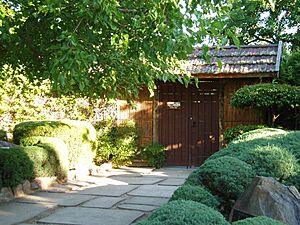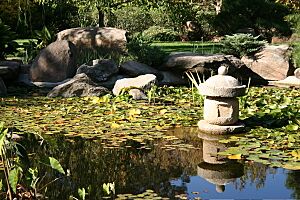Adelaide Himeji Garden facts for kids
The Adelaide Himeji Gardens are a beautiful Japanese garden located in Adelaide, South Australia. These gardens were a special gift from Himeji, a city in Japan, to Adelaide in 1982. Himeji is Adelaide's "sister city", which means the two cities have a special friendship and work together on cultural projects.
You can find the gardens in Park 18 (also known as Peppermint Park or Wita Wirra). This is one of the southern parts of the large park lands that surround the city of Adelaide. The main entrance is on South Terrace, between Pulteney Street and Hutt Street.
The Story of the Gardens
The idea for the gardens started in 1982 when Adelaide and Himeji became sister cities. At first, people from the Adelaide city council and the local Japanese community worked together to design the garden. However, some people felt the first design wasn't quite right for a traditional Japanese garden. For example, it had a regular fence instead of a more natural one.
In 1986, a famous Japanese garden designer named Yoshitaka Kumada came to help. He created new plans to make the garden truly special. He even picked out specific trees and shrubs from Melbourne and stones from near Adelaide to use in the design.
Work on the new garden began in May 1987. Before starting, a special Shinto ceremony was held. Shinto is a traditional Japanese religion, and this ceremony was a way to bless the ground. Mr. Kumada himself watched over the whole project to make sure everything was perfect.
The small lake in the garden was reshaped, and the "Sea of Sand" (a special rock garden) was made larger. The garden was filled with carefully chosen plants and decorations. One important gift from Himeji was a large granite lantern, called an Okunoin lantern, which arrived in 1985.
The new design was finished in 1989. Mr. Kumada continued to visit the gardens every year in the early 1990s. He would make small adjustments and teach the gardeners from the city council how to properly care for the garden in the Japanese style.
What You'll See in the Gardens
Many of Mr. Kumada's original design ideas are still part of the gardens today. For example, the paving stones are placed in a way that makes you walk slowly, encouraging you to relax and enjoy the scenery.
The garden is divided into two main parts:
- A "mountain and lake garden" (called sansui in Japanese). This part has a small lake and plants that look like mountains and valleys.
- A "dry rock garden" (called kare-sansui). This part uses rocks and sand to create the feeling of mountains surrounded by water, even the ocean. The sand is raked into patterns that look like waves.
The gardening team at the city council still uses the special techniques that Mr. Kumada taught them. They take great care of the "Sea of Sand," making sure the patterns in the sand always look like waves coming to shore or straight lines representing the ocean.



